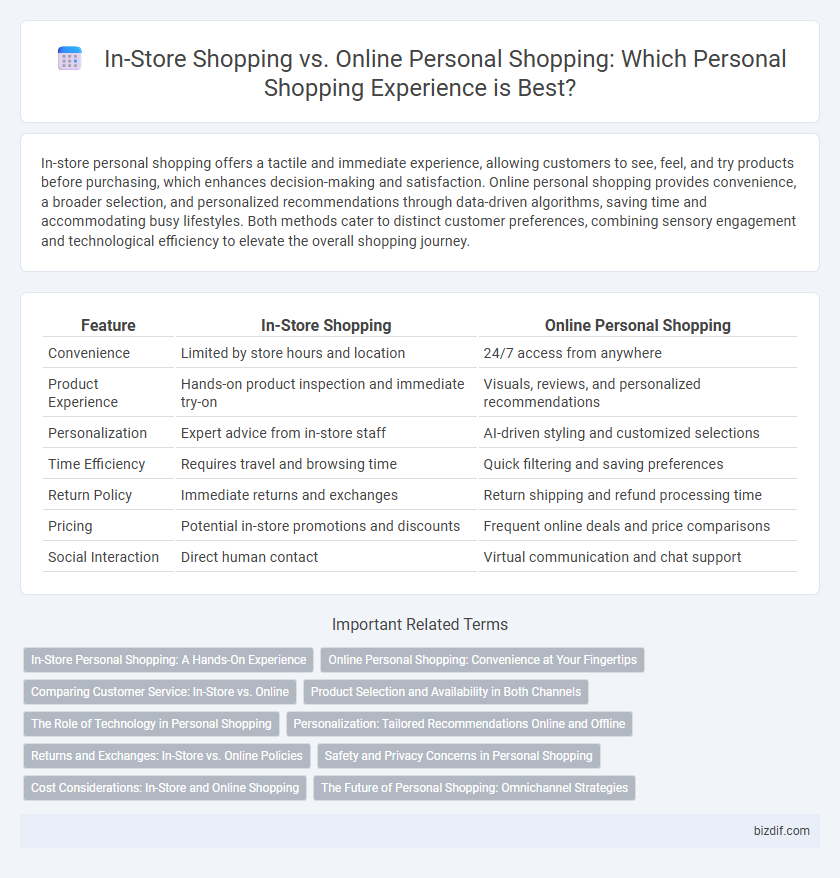In-store personal shopping offers a tactile and immediate experience, allowing customers to see, feel, and try products before purchasing, which enhances decision-making and satisfaction. Online personal shopping provides convenience, a broader selection, and personalized recommendations through data-driven algorithms, saving time and accommodating busy lifestyles. Both methods cater to distinct customer preferences, combining sensory engagement and technological efficiency to elevate the overall shopping journey.
Table of Comparison
| Feature | In-Store Shopping | Online Personal Shopping |
|---|---|---|
| Convenience | Limited by store hours and location | 24/7 access from anywhere |
| Product Experience | Hands-on product inspection and immediate try-on | Visuals, reviews, and personalized recommendations |
| Personalization | Expert advice from in-store staff | AI-driven styling and customized selections |
| Time Efficiency | Requires travel and browsing time | Quick filtering and saving preferences |
| Return Policy | Immediate returns and exchanges | Return shipping and refund processing time |
| Pricing | Potential in-store promotions and discounts | Frequent online deals and price comparisons |
| Social Interaction | Direct human contact | Virtual communication and chat support |
In-Store Personal Shopping: A Hands-On Experience
In-store personal shopping offers a hands-on experience that allows customers to physically touch, try on, and assess products, ensuring a perfect fit and quality before purchase. Expert personal shoppers provide immediate, tailored assistance and style advice based on real-time interactions and visual cues. This tactile engagement enhances customer satisfaction and reduces the likelihood of returns compared to online personal shopping.
Online Personal Shopping: Convenience at Your Fingertips
Online personal shopping offers unparalleled convenience by allowing customers to browse and purchase items from the comfort of their homes, eliminating the need for travel and in-store queues. Personalized recommendations powered by AI and customer behavior analytics enhance the shopping experience, making it tailored and efficient. Real-time customer support and flexible delivery options further streamline the process, ensuring satisfaction and time savings for busy shoppers.
Comparing Customer Service: In-Store vs. Online
In-store personal shopping offers direct, face-to-face customer service, allowing for immediate assistance, personalized styling advice, and hands-on product evaluation. Online personal shopping relies on virtual consultations, chat support, and detailed product descriptions, which can limit real-time interaction but provides convenience and access to broader selections. Customer satisfaction often depends on the shopper's preference for tactile experiences versus the flexibility and speed of digital communication.
Product Selection and Availability in Both Channels
In-store personal shopping offers immediate tactile experience and access to current inventory, allowing customers to select products by physically examining quality, fit, and color. Online personal shopping provides a broader product selection with extensive availability across multiple brands and styles, often augmented by personalized recommendations powered by AI algorithms. While in-store availability depends on local stock, online platforms benefit from centralized warehouses and dropshipping, ensuring wider access to diverse items and sizes.
The Role of Technology in Personal Shopping
Technology significantly enhances both in-store and online personal shopping experiences by integrating AI-driven recommendations and augmented reality tools that personalize customer choices. In-store setups increasingly incorporate smart mirrors and mobile apps to provide real-time product information and virtual try-ons, improving engagement and satisfaction. Online platforms leverage data analytics and machine learning algorithms to tailor shopping suggestions, streamline navigation, and offer personalized virtual assistance, bridging the gap between digital convenience and tailored service.
Personalization: Tailored Recommendations Online and Offline
Personal shopping offers tailored recommendations both in-store and online, enhancing customer experience through personalized product selections. In-store shopping utilizes real-time interaction and sensory engagement to customize suggestions based on immediate feedback and preferences. Online personal shopping relies on data algorithms and browsing history to deliver precise recommendations, allowing for convenient and individualized choices.
Returns and Exchanges: In-Store vs. Online Policies
In-store shopping often allows immediate returns and exchanges, providing customers with direct assistance and instant refunds or product swaps. Online personal shopping typically involves longer return windows but requires shipping items back, which can delay refunds and add complexity to exchanges. Retailers like Nordstrom and Zappos offer free return shipping and extended return policies to enhance the online shopping experience while maintaining customer satisfaction.
Safety and Privacy Concerns in Personal Shopping
In-store shopping offers immediate product inspection but raises concerns about physical safety and exposure to crowded environments, especially during health crises. Online personal shopping provides convenience and reduced physical risk, yet poses significant privacy challenges such as data breaches and unauthorized use of personal information. Protecting user data through secure payment gateways and transparent privacy policies is crucial in mitigating risks associated with online shopping platforms.
Cost Considerations: In-Store and Online Shopping
In-store personal shopping often involves additional costs such as travel expenses, parking fees, and impulse purchases driven by in-person promotions. Online personal shopping typically offers competitive pricing, discounts, and free shipping options, reducing overall expenditure. Consumers should weigh convenience and potential hidden costs to optimize their shopping budget effectively.
The Future of Personal Shopping: Omnichannel Strategies
Omnichannel strategies blend in-store and online personal shopping to create seamless customer experiences, leveraging data analytics and AI-driven personalization for tailored recommendations. Retailers integrate mobile apps, virtual try-ons, and real-time inventory checks to enhance convenience and engagement across multiple touchpoints. Future personal shopping emphasizes connectivity, enabling customers to switch effortlessly between physical stores and digital platforms while receiving consistent, personalized service.
In-store shopping vs Online personal shopping Infographic

 bizdif.com
bizdif.com